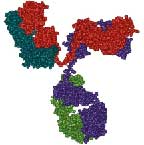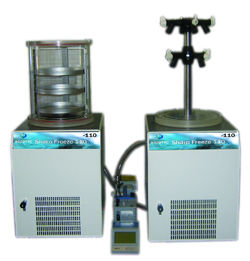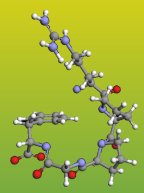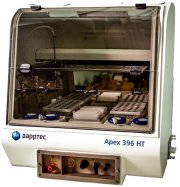|
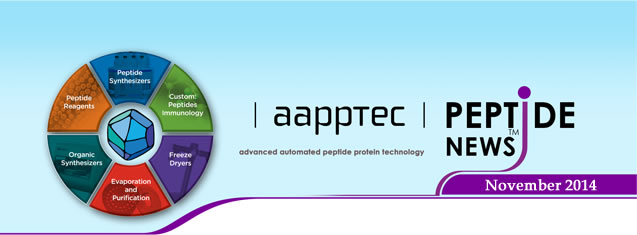 |
|
Recent Publications Cell-penetrating Helical Peptides Having L-Arginines and Five-membered Ring α,α-Disubstituted α-Amino Acids Takuma Kato, Makoto Oba, Koyo Nishida, and Masakazu Tanaka, Bioconjugate Chem., Just Accepted Manuscript DOI: 10.1021/bc5003949 Publication Date (Web): September 4, 2014 Copyright © 2014 American Chemical Society Cell-penetrating peptides are powerful tools in the delivery of drugs, proteins, and nucleic acids into cells; therefore, a focus has recently been placed on their development. In this study, we synthesized seven types of peptides possessing three L-arginines (L-Arg) and six L-leucines (L-Leu) and/or 1-aminocyclopentane-1-carboxylic acids (Ac5c), and investigated their secondary structures and cell-penetrating abilities. The peptide composed of an equal number of L-Arg, L-Leu, and Ac5c formed 310/α-helical structures in TFE solution and exhibited the highest cell-penetrating ability of all the peptides examined. Additional cellular uptake studies revealed that the incorporation of Ac5c into peptides led to improved tolerability against serum. The results of the present study will help in the design of novel cell-penetrating peptides. Z-selective olefin metathesis on peptides: investigation of side-chain influence, preorganization, and guidelines in substrate selection. Mangold SL, O'Leary DJ, Grubbs RH., J Am Chem Soc., 2014 Sep 3;136(35):12469-78. doi: 10.1021/ja507166g. Epub 2014 Aug 20. Olefin metathesis has emerged as a promising strategy for modulating the stability and activity of biologically relevant compounds; however, the ability to control olefin geometry in the product remains a challenge. Recent advances in the design of cyclometalated ruthenium catalysts has led to new strategies for achieving such control with high fidelity and Z selectivity, but the scope and limitations of these catalysts on substrates bearing multiple functionalities, including peptides, remained unexplored. Herein, we report an assessment of various factors that contribute to both productive and nonproductive Z-selective metathesis on peptides. The influence of sterics, side-chain identity, and preorganization through peptide secondary structure are explored by homodimerization, cross metathesis, and ring-closing metathesis. Our results indicate that the amino acid side chain and identity of the olefin profoundly influence the activity of cyclometalated ruthenium catalysts in Z-selective metathesis. The criteria set forth for achieving high conversion and Z selectivity are highlighted by cross metathesis and ring-closing metathesis on diverse peptide substrates. The principles outlined in this report are important not only for expanding the scope of Z-selective olefin metathesis to peptides but also for applying stereoselective olefin metathesis in general synthetic endeavors. O-Acyl isopeptide method: development of an O-acyl isodipeptide unit for Boc SPPS and its application to the synthesis of Aβ1-42 isopeptide. Yoshiya T, Uemura T, Maruno T, Kubo S, Kiso Y, Sohma Y, Kobayashi Y, Yoshizawa-Kumagaye K, Nishiuchi Y., J. Pept. Sci., 2014, 20, 669-74. doi: 10.1002/psc.2662. Epub 2014 May 28. The O-acyl isopeptide method was developed for the efficient preparation of difficult sequence-containing peptide. Furthermore, development of the O-acyl isodipeptide unit for Fmoc chemistry simplified its synthetic procedure by solid-phase peptide synthesis. Here, we report a novel isodipeptide unit for Boc chemistry, and the unit was successfully applied to the synthesis of amyloid β peptide. Combination of Boc chemistry and the isodipeptide unit would be an effective method for the synthesis of many difficult peptides. Copyright © 2014 European Peptide Society and John Wiley & Sons, Ltd. Taximin, a conserved plant-specific peptide is involved in the modulation of plant-specialized metabolism. R, Goethals M, Gevaert K, Moyano E, Vidal-Limon H, Cusidó RM, Palazón J, Goossens A, Plant Biotechnol. J., 2014, 12, 971-83. doi: 10.1111/pbi.12205. Epub 2014 May 23. Small peptides play important roles in the signalling cascades that steer plant growth, development and defence, and often crosstalk with hormonal signalling. Thereby, they also modulate metabolism, including the production of bioactive molecules that are of high interest for human applications. Yew species (Taxus spp.) produce diterpenes such as the powerful anticancer agent paclitaxel, the biosynthesis of which can be stimulated by the hormone jasmonate, both in whole plants and cell suspension cultures. Here, we identified Taximin, as a gene encoding a hitherto unreported, plant-specific, small, cysteine-rich signalling peptide, through a transcriptome survey of jasmonate-elicited T. baccata suspension cells grown in two-media cultures. Taximin expression increased in a coordinated manner with that of paclitaxel biosynthesis genes. Tagged Taximin peptides were shown to enter the secretory system and localize to the plasma membrane. In agreement with this, the exogenous application of synthetic Taximin peptide variants could transiently modulate the biosynthesis of taxanes in T. baccata cell suspension cultures. Importantly, the Taximin peptide is widely conserved in the higher plant kingdom with a high degree of sequence conservation. Accordingly, Taximin overexpression could stimulate the production of nicotinic alkaloids in Nicotiana tabacum hairy root cultures in a synergistic manner with jasmonates. In contrast, no pronounced effects of Taximin overexpression on the specialized metabolism in Medicago truncatula roots were observed. This study increases our understanding of the regulation of Taxus diterpene biosynthesis in particular and plant metabolism in general. Ultimately, Taximin might increase the practical potential of metabolic engineering of medicinal plants. Epitope mapping of the N-terminal portion of tissue transglutaminase protein antigen to identify linear epitopes in celiac disease. Di Pisa M1, Buccato P, Sabatino G, Real Fernández F, Berti B, Cocola F, Papini AM, Rovero P, J. Pept. Sci., 2014, 20, 689-95. doi: 10.1002/psc.2650. Epub 2014 May 15. Celiac disease (CD) is an autoimmune mediated disease with complex and multifactorial etiology. Gluten intake triggers a composite immune response involving T-cells and B-cells and leading to the secretion of autoantibodies if a genetic predisposition is present. Untreated CD patients show high levels of circulating autoantibodies directed to different auto-antigens present in the intestinal mucosa. The most important auto-antigen is the endomysial enzyme tissue transglutaminase (tTG). Both IgA and IgG antibody isotypes to tTG are known, but only the IgA antibodies demonstrate the highest disease specificity and thus are considered disease biomarkers. Because the pathogenicity and exact tTG binding properties of these autoantibodies are still unclear, the characterization of tTG antigenic domains is a crucial step in understanding CD onset and the autoimmune pathogenesis. Overlapping peptide libraries can be used for epitope mapping of selected protein portions to determine antigenic fragments contributing to the immunological activity and possibly develop innovative peptide-based tools with high specificity and sensitivity for CD. We performed an epitope mapping study to characterize putative linear auto-antigenic epitopes present in the tTG N-terminal portion (1-230). A library of 23 overlapping peptidesspanning tTG(1-230) was generated by Fmoc/tBu solid-phase peptide synthesis and screened by immunoenzymatic assays employing patients' sera. The results indicate that four synthetic peptides, that is, Ac-tTG(1-15)-NH2 , Ac-tTG(41-55)-NH2 , Ac-tTG(51-65)-NH2 , and Ac-tTG(151-165)-NH2 , are recognized by IgA autoantibodies circulating in CD patients' sera. These results offer important insight on the nature of the antigen-antibody interaction. Copyright © 2014 European Peptide Society and John Wiley & Sons, Ltd. |
|
Custom Peptide Synthesis 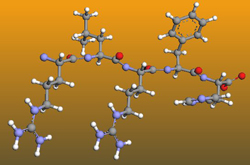 AAPPTec provides high quality custom peptides quickly at very competitive prices. Our peptide chemists have prepared peptides with up to 80 to 100 residues in high purity. They have decades of experience preparing and purifying all types of peptides, including hydrophobic peptides, cyclized peptides and peptides conjugated to biotin, fatty acids or dyes. Most modifications, such as phosphorylation, unusual amino acids, side chain labels and fluorescent tags, can be incorporated. To request a quotation for custom peptides, e-mail your sequences, the quantity of each peptide and the purity you require to info@aapptec.com or use our convenient online quotation request form at www.aapptec.com. AAPPTec Custom Antibodies
AAPPTec provides custom polyclonal or custom monoclonal antibodies at very competitive prices. AAPPTec offers polyclonal or monoclonal antibody production packages that include peptide synthesis, conjugation to antigen, injection into animals, serum collection, antibody purification and antibody testing. For more information, visit our website www.aapptec.com. Sharp FreezeTM Lyophilizers
Sharp FreezeTM Lyophilizers can reach temperatures as low as –110°C. When equipped with AAPPTec vacuum pumps which produce vacuums below 0.003 mbar, AAPPTec's freeze dryers provide fast, efficient lyophilization with a small, space saving footprint. Sharp Freeze lyophilizers are microprocessor controlled with overload and malfunction alarms. Digital models include built-in vacuum sensing to 0.001 mbar, digital readout and USB port for optional data logging. The condensers of Sharp Freeze lyophilizers are
constructed of chemically resistant AISI 316 stainless steel. Optional glass inserts are available for corrosive solvents. Sharp Freeze lyophilizers are available with an optional electric de-icing function for rapid de-icing and cleaning of the condenser.
AAPPTec Peptide Catalog AAPPTec’s On Line Peptide Catalog contains over 2100 peptide products at very competitive prices. The Peptide Catalog includes peptides in these classes: Click here to view AAPPTec’s on line Peptide Catalog. β-Amino Acids and
β-Homoamino Acids
Beta-amino acids and beta-homoamino acids incorporated into peptides can increase resistance to digestive enzymes, improve selectivity, enhance potency and increase metabolic stability, making them interesting drug candidates. Antibactials, opioid peptide analogs, and drugs for cancer treatment are a few examples of the applications of ß-peptides. (K. Stachowiak, et al., J Med Chem. 1979, 22, 1128-30; KM Bromfield, et al., Chem Biol Drug Des. 2006, 68, 11-9; S Nordhoff, et al., Bioorg Med Chem Lett. 2009, 19, 6340-5; MA Ondetti, SL Engel, J Med Chem. 1975, 18, 761-3; D Janke, et al., Bioorg. Med. Chem., 2011, 19, 7236).
Apex 396 HT Library Synthesizer For high-throughput synthesis of peptide libraries, the Apex 396 HT is unsurpassed. It synthesizes up to 192 different sequences at the same time using standard 1 mL well titer plates. The Apex 396HT can prepare up to 96 peptides in larger quantities utilizing standard AAPPTec reactor assemblies. The Apex 396HT features four 800 mL reagent bottles and two racks each holding 36 amino acid vessels. For more information about the Apex 396HT, please visit the Apex 396 HT page at www.aapptec.com.
|
 |
UPCOMING EVENTS |
|
|
November 2014 Peptide Drug Design and Delivery Congress November 5-6 34th International Symposium on the Separation of Proteins, Peptides and Polynucleotides November 5-7 |
 |
